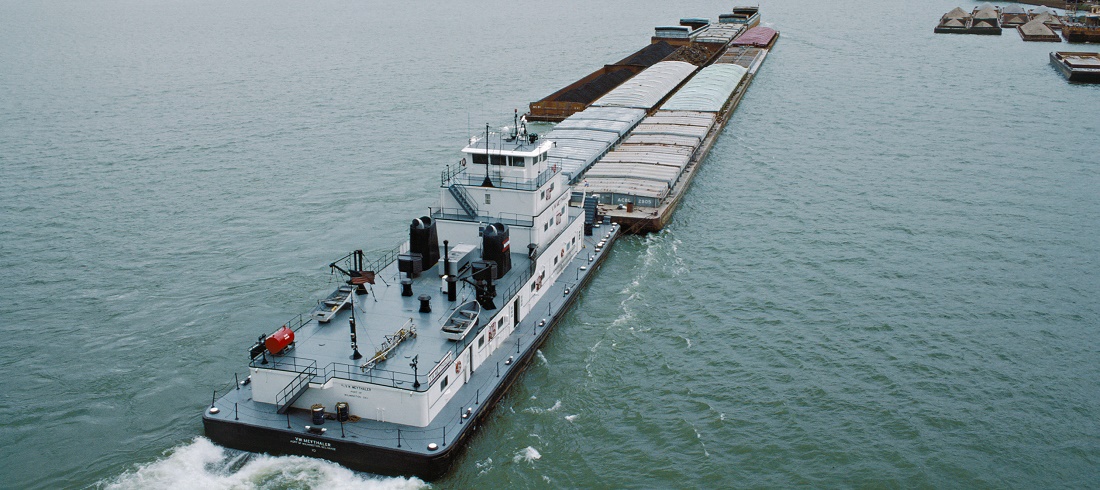
Still restricted, Paraguay River makes comeback as export outlet
Oct, 21, 2022 Posted by Gabriel MalheirosWeek 202242
Commercial shipping operations are once again taking place on the Paraguay River waterway, despite the persisting draft restrictions caused by less rainfall in the river basin, with another year of drought predicted ahead.
The Granel Química terminal in Ladário resumed iron ore exports to the Argentine port complex. In addition, FV Cereals, from Porto Murtinho, is preparing to start loading soybeans to the same destination from the second fortnight of February.
Activities in the waterway were halted between September and October 2021, when the Paraguay River reached historic lows, with the estimate of a record in exports not confirmed.
With contracts for the movement of 400 thousand tonnes of soybeans and expectations of reaching 700 thousand tonnes on the horizon, FV Cereais managed to export 250 thousand tonnes. Granel Química handled 50% (900,000 tonnes) of the expected iron ore cargo from Vale and Vetria.
According to Luiz Dresch from Granel Química, “this will be a year of good volumes,” projecting the output of two million tonnes of iron ore and barges returning from Argentina with 100,000 m3 of diesel that Bolivia imported from the United States.
FV Cereais also sees an optimistic scenario, expecting a higher demand than in recent years due to the significant drop in soybean crops in Argentina and Paraguay.
Navigation
The Ladário terminal has been operating since the first week of January with a still-rising draft of more than seven feet (2.10 meters), allowing 1,500-ton barges to navigate at 70% capacity.
Although the level of the Paraguay River is still at 1.15 meters, according to the Navy on Oct 19, the channel of the port owned by Granel Química is currently at 2.50 meters (eight feet).
In Porto Murtinho, the level of the Paraguay River is slowly rising (it marked 1.97 meters on the 19th and should reach 2.30 meters in three weeks, a navigable draft.
FV Cereais begins to receive soybeans as of February 10, transported by trucks from the production centers along the BR-267 highway.
Its warehouses have a storage capacity of 30 thousand tonnes of grain. Last year, the terminal started shipments to San Lorenzo (Argentina) on February 15.
According to Genivaldo Santos, Operations Manager at FV Cereais, the company’s expectations are to “speed up exports to meet demand. However, the ability to do so will depend on the number of convoys available, which exporters contract.”
The navigability conditions of the Paraguay River, however, indicate that 2023 will be another difficult year due to the lack of rain in the headwaters.
In Cáceres (MT), the river began to recede after reaching 3.26 meters on January 12 – the lowest volume of water in six years.
In Ladário’s ruler, the level is also lower than in previous years. In Porto Murtinho, it is no different: it is below 1.89 meters compared to the 2021 level.
Logistics
The Secretary of State for the Environment, Economic Development, Production, and Family Agriculture, Jaime Verruck, explains that the Paraguay River waterway is an important logistical axis for transporting goods in Mato Grosso do Sul.
“Hence the importance of resuming navigability. The government’s mission was to transform the waterway into a pivotal logistical axis for Mato Grosso do Sul. This was a highly important point,” the secretary emphasized while recalling that the route connects Paraguay, Argentina, and Bolivia.
Verruck also points out that the stoppage of the movement of goods in the waterway generates greater pressure on road transport.
“This created pressure on the highways, mainly ore trucks moving from Corumbá, along the BR-262 highway to the state of São Paulo. So this increased the level of car accidents and deterioration of the roadbed. That was a point of concern of ours,” says Verruck.
All things considered, port facilities in Brazil’s central states were still busy last year.
In the specific case of Porto Gregório Curvo and the Granel Química terminal in Mato Grosso do Sul, both stood out in terms of increased output.
For example, the throughput at the Port Gregório Curvo in Ladário was 1.8 million tonnes from January to November.
The Granel Química terminal in Ladário was responsible for the transport of 979 thousand tonnes, an increase of 164.61% from the same period of the previous year.
Source: Correio do Estado
To read the full original article, please go to: https://correiodoestado.com.br/economia/hidrovia-do-rio-paraguai-volta-a-exportar-mas-com-restricoes/395927/
-
Economy
Mar, 02, 2023
0
Brazilian trade balance accumulates USD 2.837 bln in February
-
Trade Regulations
Jun, 23, 2023
0
Lula deems EU proposal ‘unacceptable,’ but still bets on an agreement
-
Economy
Dec, 02, 2019
0
Trade balance closes November with lowest surplus since 2015
-
Ports and Terminals
Oct, 03, 2023
0
São Francisco do Sul seeks solutions for increasing port traffic


